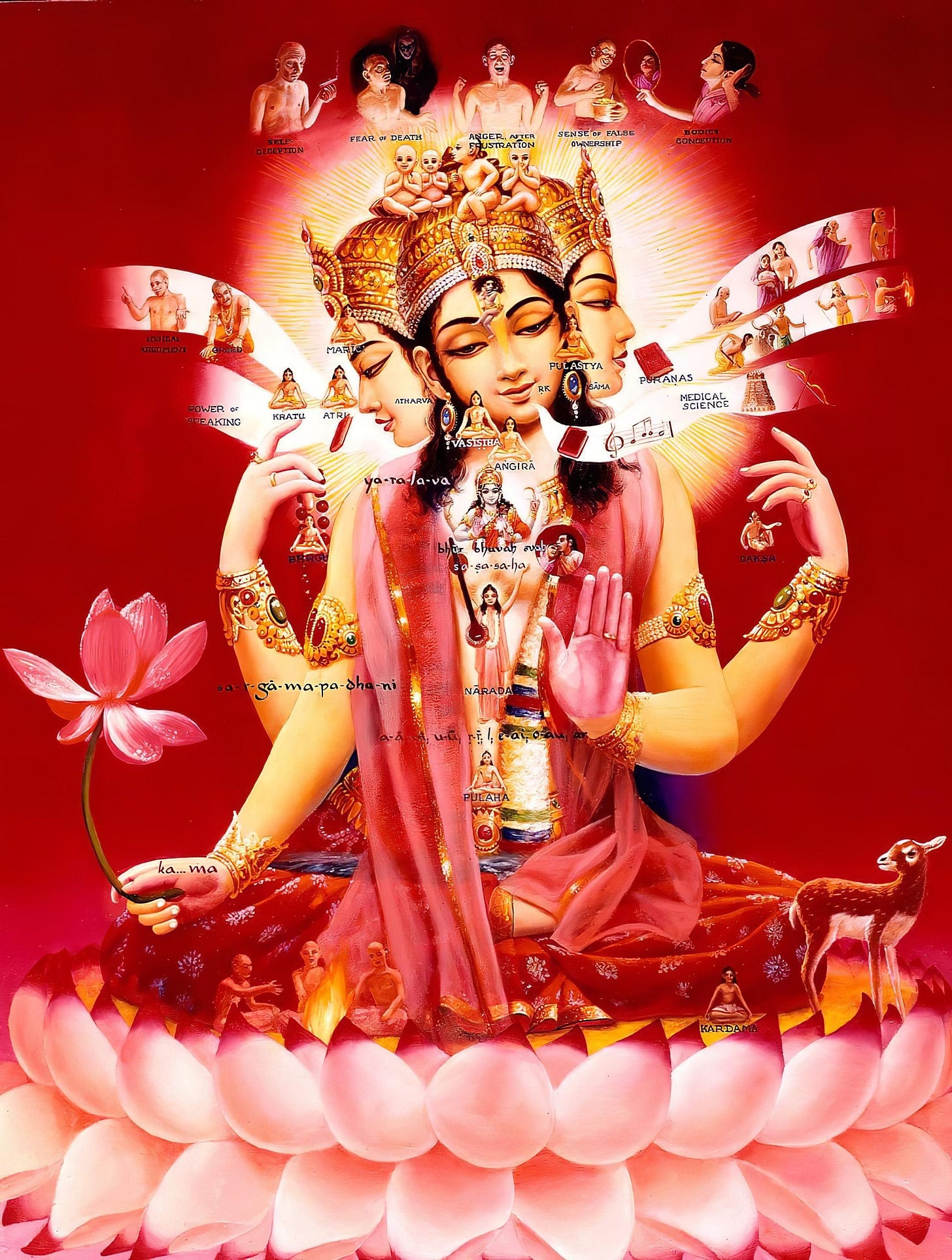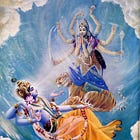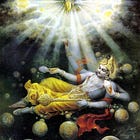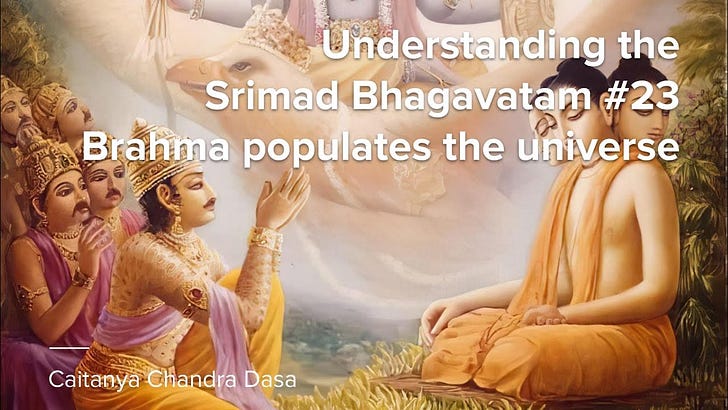Brahma populates the universe
When Brahma woke up at the beginning of his current day, there was just darkness. Everything had to be re-created from the material elements stored in the lotus flower from which he was born.
When Brahma woke up at the beginning of his current day, there was just darkness. Everything had to be re-created from the material elements stored in the lotus flower from which he was born. This process continued all the way to the creation of Svayabhuva Manu and his wife Satarupa.
Its described how Brahma created different species such as the Yakṣas and Rākṣasas, the demigods and demons, Gandharvas and Apsarās, ghosts and spirits, the Sādhyas and Pitās, Siddhas and Vidyādharas, Kimpuruṣas and Kinnaras, Nagas, and so on, as well as the Manus and the great sages. All these different species came from different states of consciousness of Lord Brahma, as well as different parts of his body.
The first creation of Brahma was the ignorance that covers all conditioned souls and makes them identify with matter. There are five types of covering of ignorance, which delude the souls and prevent them from reconnecting with their original nature:
a) Tāmisra: Anger, or envy. Under this covering, a soul forgets his constitutional nature and desires to compete with the Lord, becoming a false enjoyer in this material world. Although tāmisra also applies to general anger and envy of other living beings, the origin of it is one's anger and envy towards the Lord. By envying God as the ultimate controller and enjoyer, we also envy other people who have more than us. This envy leads to anger, and anger makes us fall even deeper into ignorance.
It's important to note that this hatred of God doesn't come from the soul, but from this conditioning by tāmisra. Originally, the soul develops some kind of reluctance in serving Krsna, and from this, the soul comes in contact with the material energy. From this contact with the material energy, the soul can gradually, due to its free will, fall more and more under the control of tāmisra to the point of becoming a demon or atheist.
b) Andha-tāmisra: "I'm the body and death is the end of everything". Once one falls under this type of ignorance, one becomes propense to commit sinful activities, without believing one may be punished for it. Since one believes there is no hell, karma, or afterlife, one thus feels free to do anything that can help to enjoy one's senses, no matter how sinful. This condition of andha-tāmisra is due to the next covering, tamas.
c) Tamas: Ignorance of one's constitutional positions as a soul, which is the origin of andha-tāmisra and the other coverings. As Prabhupada explains: "Almost everyone is thinking that he is this body; he has no information of the spirit soul. Guided by this misconception, one always thinks, “This is my body, and anything in relationship with this body is mine.” For such misguided living entities, sex life is the background of material existence."
d) Moha: Attachment and sense of possession for things connected with the body, such as material possessions, relatives, society, and so on. This sense of “I am this body, and everything belonging to this body is mine” starts with sex life and is increased by it. Because of this false sense of proprietorship, sectarian societies, families, and nationalities are created, and they fight with one another.
e) Mahā-moha: Madness after sense enjoyment. This is the basic mechanism we use to enjoy the world is the mind, which stores impressions and images, and based on that, desires different material objects. The more we become involved with material enjoyment, the more strongly the mind desires these things, to the point that one becomes mad. That's why the Vedas allow sense enjoyment only under certain restrictions (food only as prasāda, sex life only in married life, etc.) If we don't follow these regulations, we risk falling under mahā-moha and becoming mad.
As you can see, these five forms of ignorance form a dangerous sequence. First, the soul becomes reluctant to the service of the Lord, and eventually comes under the covering of ignorance, desiring to become a competitor to the Lord, enjoying this material world. For this, the soul has to forget one’s eternal spiritual identity and identify with a material body, becoming attached to one’s birthplace, family and friends, material possessions, and so on. This increases his illusion, making the soul absorbed in the material duality of dividing things into desirable and undesirable, friends and enemies, etc. This makes one very active in the material platform, more and more entangled by envy, anger, and desire, and as a result, one becomes mad after sense enjoyment, gradually becoming more and more sinful and gradually falling into the lower species of life, where ignorance increases, making one completely forget his original nature as a soul.
It's not possible to enjoy the material world without falling into these varieties of illusion, and gradually gliding down to the lower species. The only way to avoid this path is to gradually abandon our propensity to enjoy matter and to compete with Krsna by following the principles of the scriptures and gradually abandoning this enjoying mentality. The more we desire to enjoy in this material world, the more we forget about Krsna and vice versa. One may try to combine both paths to a certain degree, but they go ill together. Ultimately, one has to make one’s choice.
What did Brahma do after creating these coverings of ignorance?
"Out of disgust, Brahmā threw off the body of ignorance, and taking this opportunity, Yakṣas and Rākṣasas sprang for possession of the body, which continued to exist in the form of night. Night is the source of hunger and thirst." (SB 3.20.19)
Although Brahma performed his duty in creating these coverings of ignorance, he didn't like it, and thus he threw away the body used for this creation.
Yakṣas, and Rākṣasas as well as other lower beings who were created together with these different coverings of ignorance, took possession of this body. Although living in the planetary system of Bhuvarloka (the planetary system directly above us), and being associated with Kuvera, Yakṣas, and Rākṣasas are considered beings in the mode of ignorance who are cannibals. This body of Brahma became the night, which is very much appreciated by all kinds of evil beings. Night is also the source of hunger and thirst, and overpowered by this hunger and thirst, the Yakṣas and Rākṣasas attacked Brahma, trying to devour him. Brahma had to beg them to stop, explaining he was their father.
Brahma then created the shining demigods, together with the effulgent daytime. Just like the Rākṣasas took procession of the night, the demigods took procession of the day. Generally, beings in the mode of goodness are active during the day, as well as the early hours of morning, while beings in ignorance are more active at night. That's why one of the principles of spiritual life is to wake up early to chant and perform other spiritual practices. This helps us to situate ourselves in this state of consciousness.
Brahma then gave birth to the demons from his buttocks. Demons are influenced by the mode of passion and are very fond of sex. As Prabhupada mentions, "The more one is free from the desire for sex, the more he is promoted to the level of the demigods; the more one is inclined to enjoy sex, the more he is degraded to the level of demoniac life."
Because of their sexual appetite, demons harass everyone, and even Brahma had problems with it. As soon as he created the demons, they became lustful and went after him for sex. Demons are so fond of sex that they have no respect even for their father. Anyone, be it a man or a woman, can become the target of their lust. When one's sexual impulse is controlled, one can engage it to beget children inside family life, according to religious principles, but when one loses control over it, there are no limits.
At first, Brahma laughed at their foolishness, but as they came closer, Brahma became afraid and ran out of fear, approaching the Lord for protection. This shows how the material world is a dangerous place. Even if one becomes Brahma, one is not safe.
The Lord told Brahma to abandon the body he used to create the demons, referring to it as impure. Brahma immediately abandoned his body, and thus he was saved from the demons. Prabhupada explains that Brahma abandoning these different bodies doesn't mean abandoning a physical body, but abandoning a particular type of mentality. As he mentions:
"According to Śrīdhara Svāmī, Brahmā’s constant dropping of his body does not refer to his actually giving up his body. Rather, he suggests that Brahmā gave up a particular mentality. Mind is the subtle body of the living entity. We may sometimes be absorbed in some thought which is sinful, but if we give up the sinful thought, it may be said that we give up the body. Brahmā’s mind was not in correct order when he created the demons. It must have been full of passion because the entire creation was passionate; therefore such passionate sons were born."
Brahma does not have a physical body like us. He performs the creation using his subtle body, composed of mind, intelligence, and ego. However, as mentioned in the second canto, this subtle body assumes different forms that act like gross bodies according to his different mental states. As he changes between these different states of consciousness, these "bodies" are discarded.
This body Brahma used to create the demons became the evening twilight, a time of the day that inspires passion. The asuras took procession of this time, taking it as a beautiful damsel. Prabhupada explains that "as early morning is the period for spiritual cultivation, the beginning of evening is the period for passion."
Several verses in the 20th chapter of the 3rd canto are dedicated to describing the physical features of this girl and the way the lustful demons approached her. This description appears to describe the interaction of the demons with the predominating deity of the evening twilight, but it also serves as a description of the mentality of the demons in being enamored by the false beauty of this material world.
If we cut out any piece of a beautiful material body, like a nail, a finger, a bunch of hair, a piece of skin, an eye, a tooth, etc., we will not find any beauty there. Separated, all parts of a beautiful body are ghastly. However, when these material elements are together, we, under the influence of material illusion, somehow find it attractive. Demons are very attracted by this false beauty of the material world, but a godly person learns to control such attraction and see through the illusion by cultivating spiritual knowledge.
Having finished this unpleasant part of creation, Brahma developed his sense of loveliness, which gave birth to the Gandharvas and Apsaras, who are very fond of music and beauty. As Brahma gave up the body he used for this creation, it became the moonlight, which was taken procession by the Gandharvas.
At some point, Brahma felt somehow lazy, and from this laziness, he created the ghosts and evil spirits (piśācās), who attack people who are impure. When he gave up this body, it took the form of yawning.
In a similar way, Brahma created the Sādhyas and Pitās, the Siddhas and Vidyādharas, as well as the Kimpuruṣas and Kinnaras. The Sādhyas are a type of demigods who take charge of mantras and rituals, the Pitās are the spirits of the ancestors, who can continue existing in Pitrloka if their descendants offer them oblations as prescribed in the Vedas. The Siddhas and Vidyādharas are inhabitants of celestial planets who have mystic perfections, such as traveling in space and becoming invisible, while the Kinnaras and Kimpuruṣas are inhabitants of other islands of Bhu-Mandala. They have a great artistic sense, and forms that are a mixture of human and animal forms.
Read also:
If you read this article to the end, give it a like. This makes Substack recommend it to more people.






Hare Krishna
Beautiful Description.